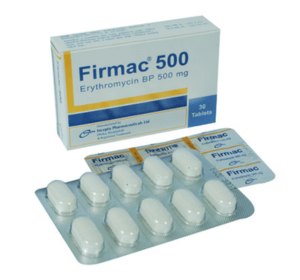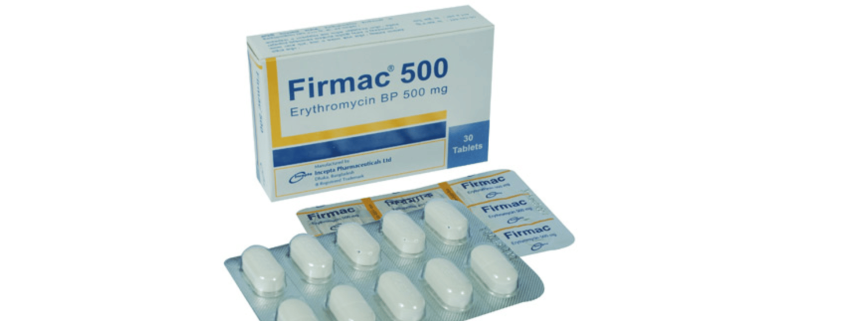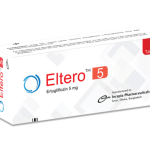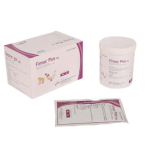Firmac(Erythromycin)

Therapeutic Group: Anti Bacterial
Presentation
Firmac 250: Each tablet contains Erythromycin Stearate BP equivalent to Erythromycin 250 mg.
Firmac : Each tablet contains Erythromycin Stearate BP equivalent to Erythromycin 500 mg.
Firmac Dry Suspension: After reconstitution, each 5 ml suspension contains Erythromycin Ethylsuccinate BP equivalent to Erythromycin 125 mg.
Description
Erythromycin is highly effective against most strains of the following microorganisms, both in vitro and in clinical infections:
Gram-positive microorganisms: Streptococcus pneumoniae, Streptococcus pyogenes, Staphylococcus aureus, Corynebacterium diphtheriae, Corynebacterium minutissimum and Listeria monocytogenes.
Gram-negative microorganisms: Haemophilus influenzae, Bordetella pertusis, Legionella pneumophilia, Campylobacter jejuni and Neisseria gonorrhoeae.
Other microorganisms: Mycoplasma pneumoniae, Chlamydia trachomatis, Entamoeba histolytica, Treponema pallidum and Ureaplasma urealyticum.
Indications
Erythromycin is highly effective in the treatment of great variety of clinical infections caused by Erythromycin sensitive microorganisms.
Upper respiratory tract infections: Tonsillitis, peritonsillar abscess, pharyngitis, laryngitis, sinusitis, secondary infections in cold and influenza.
Lower respiratory tract infections: Tracheitis, acute & chronic bronchitis, pneumonia (lobar pneumonia, bronchopneumonia, primary atypical pneumonia), bronchiectasis, legionnaires’ diseases.
Ear infections: Otitis media and Otitis externa, mastoiditis.
Oral infections: Gingivitis, Vincent’s angina.
Eye infection: Blepharitis.
Skin & Soft tissue infections: Boils and carbuncles, paronychia, abscesses, pustular acne, impetigo, cellulites, erysipelas.
Gastrointestinal infections: Cholecystitis, staphylococcal enterocolitis.
Prophylaxis: Pre- and Post operative trauma, burns, rheumatic fever.
Other infections: Osteomyelitis, urethritis, gonorrhoea, syphilis, lymphogranuloma venerum, diphtheria, prostitis, scarlet fever.
Dosage & Administration
Adult and Child over 8 years: 250-500 mg every 6 hours or 0.5-1gm every 12 hours. This may be increased up to 4 gm daily according to severity of infections.
Child of 2-8 years: 250 mg every 6 hours, doses doubled for severe infections.
Child up to 2 years: 125 mg every 6 hours.
Neonates: 30 – 45 mg/kg daily in 3 divided doses.
Elderly: Same as for adults.
If administration on a twice daily schedule is desirable, one half of the total daily dose may be given every 12 hours, one hour before meal.
Amoebic dysentery
Adult: 250 – 500 mg four times daily for 10 – 14 days.
Children: 30 – 50 mg/kg/day in divided doses for 10 – 14 days.
Pertussis: 30 – 50 mg/kg/day in divided doses for 5 – 14 days depending upon eradication of a positive culture.
Streptococcal infections: In the treatment of group A beta haemolytic streptococcal infections, therapeutic dosage of Erythromycin should be administered for at least 10 days.
Acne: The usual dosage regimen of erythromycin in the treatment of acne is 500 mg twice daily for 3 months. Then the dose is to be reduced to 250 mg twice daily for another 3 months.
Early Syphilis: 500 mg 4 times daily for 14 days.
Uncomplicated genital Chlamydia nongonococcal Urethritis: 500 mg twice daily for 14 days.
Prophylaxis: In continuous prophylaxis of streptococcal infections in person with a rheumatic heart disease, the dosage is 250 mg twice daily.
When Erythromycin is used prior to surgery to prevent endocarditis caused by alpha haemolytic streptococci, a recommended schedule for children – 20 mg/Kg 1.5 – 2 hours pre-operatively and 10 mg/kg every 6 hours for 8 doses post-operatively. For adults, the dose is 1 g, 1.5 – 2 hours pre-operatively and 500 mg every 6 hours for 8 doses post-operatively.
Side Effects
Generally erythromycin is well tolerated and serious adverse effects are rare. Side-effects are gastrointestinal and are dose-related. They include nausea, vomiting, abdominal pain, diarrhea and anorexia.
Mild allergic reactions, such as urticaria and skin rashes have occurred. Serious allergic reactions, including anaphylaxis may occur.
Precautions
Since Erythromycin is metabolized principally by the liver, caution should be exercised when erythromycin is administered to patients with impaired hepatic function. There have been reports of hepatic dysfunction with or without jaundice occurring in patients taking oral Erythromycin.
Use in Pregnancy & Lactation
Pregnancy: There are no adequate and well-controlled studies in pregnant women about administration of Erythromycin therefore; this drug should be used during pregnancy only if clearly needed.
Lactation: Erythromycin is excreted in breast milk; therefore, caution should be exercised when Erythromycin is administered to a nursing woman.
Drug Interaction
Theophylline: The use of Erythromycin in patients who are receiving concomitant high doses of theophylline may be associated with an increase in serum theophylline and potential theophylline toxicity. If symptoms of toxicity develop, the dose of theophylline should be reduced.
Digoxin: Concomitant administration of Erythromycin and Digoxin has been reported to result in elevated digoxin serum levels.
Over Dose
In case of overdosage, Erythromycin should be discontinued. Overdosage should be handled with the prompt elimination of unabsorbed drug and all other appropriate measures should be instituted.
Erythromycin is not removed by peritoneal dialysis or haemodialysis.
Commercial Pack
Firmac 250 : Each box contains 5 blister strips of 10 tablets.
Firmac : Each box contains 3 blister strips of 10 tablets.
Firmac Dry Suspension: Bottle containing dry powder for 100 ml suspension.
Others
Direction for reconstitution of suspension
Shake the bottle to loosen powder. Add 60 ml (12 measuring spoonful) of boiled and cooled water to the dry powder of the bottle. For ease of preparation, add water to the bottle in two proportions. Shake well after each addition until all the powder is in suspension.
Note: Shake the suspension well before each use. Keep the bottle tightly closed. The reconstituted suspension should be stored in a cool and dry place, preferably in refrigerator and unused portion should be discarded after 7 days.



